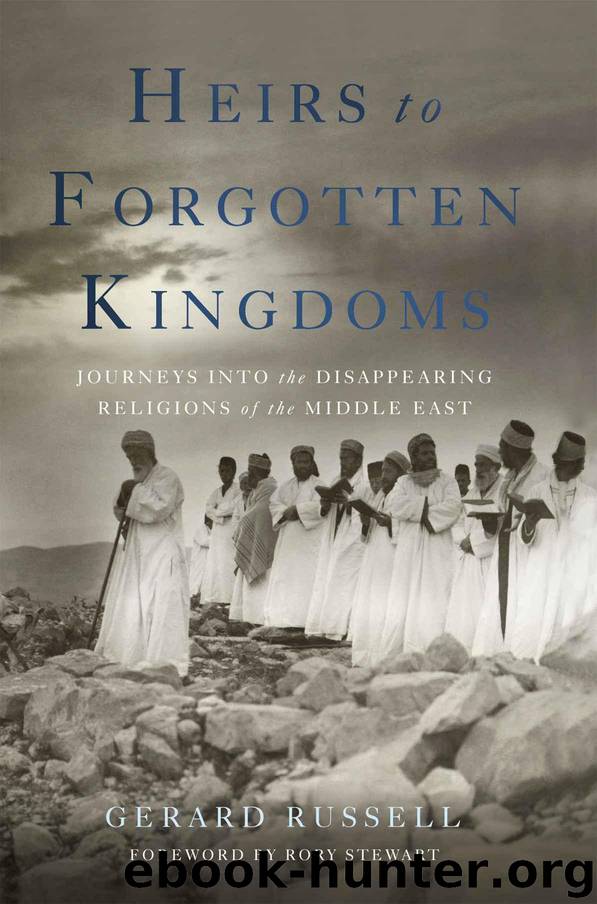Heirs to Forgotten Kingdoms: Journeys Into the Disappearing Religions of the Middle East by Russell Gerard

Author:Russell, Gerard [Russell, Gerard]
Language: eng
Format: azw3, mobi, epub
Publisher: Basic Books
Published: 2014-10-20T16:00:00+00:00
The Samaritans have preserved carefully over the generations their ancient scrolls, which record a Torah that differs somewhat from the Jewish one. Here in 1905 a Samaritan priest displays one such scroll for curious visitors. Stereograph in Views of Palestine [1905], Getty Research Institute
The prayer room faced east, and a niche at one end was sealed off with a yellow curtain, in front of which sat the white-robed high priest and his brother. There was a small clock and a menorah, the seven-branched candelabra, on the white-painted wall alongside; chandeliers and ceiling fans hung above. The building was constructed in the 1980s, but the niche housed vellum scrolls that date back centuries, possibly even millennia. Mills called them “the desire and the despair of European scholars,” and his determination to see them “grew almost into a fever.” When he eventually did, he found writing on one of them that claimed the document was written in biblical times. This was unlikely—not even vellum lasts that long—but perhaps it had been copied from a document from that period. There are seven-hundred-year-old scrolls in the British Library that were bought from the Samaritans in the nineteenth century. In places where the scrolls contain blessings that the priest touched as he recited them, the vellum is dark and worn.
The great murmuring that I had heard was produced by all of the village’s male Samaritans, dressed in thin cotton jelabas that reached down to their feet, gathered in this room and reciting prayers, each in his own time and rhythm, using different words, not in unison. Every so often they would pause and prostrate themselves on hands and knees, touching their foreheads to the floor. Prayer time is when the Samaritans cover their heads, as some devout Jews do at all times with the kippa. The Samaritans had three different styles of headgear: a white prayer cap such as Muslims wear, a red tarbush, and a black beret. The last was favored by the Samaritans who lived in Tel Aviv, as they followed slightly more modern fashions. The effect was curiously transformative. A woolen jacket worn over the jelaba and a red tarbush made a man look as though he had stepped out of a book about the Ottoman empire; the man next to him, in a raincoat and beret, looked like a French artist.
For a week before Passover the Samaritans pray morning and night; on normal Saturdays, people pray either at home or at the synagogue. The prayers were extracts from the Samaritan Torah mixed in with religious poems written by Samaritans over the centuries. Most people seemed to know these by heart, but one teenager in spectacles was reading them from a book; at the back the younger children were less involved, and one fell asleep in the corner, tarbush falling to one side. His schoolmates, giggling, asked me to take his photo. This was as far as teenage rebellion went. Not turning up for prayer at all was apparently unthinkable. One
Download
Heirs to Forgotten Kingdoms: Journeys Into the Disappearing Religions of the Middle East by Russell Gerard.mobi
Heirs to Forgotten Kingdoms: Journeys Into the Disappearing Religions of the Middle East by Russell Gerard.epub
This site does not store any files on its server. We only index and link to content provided by other sites. Please contact the content providers to delete copyright contents if any and email us, we'll remove relevant links or contents immediately.
| Buddhism | Christianity |
| Ethnic & Tribal | General |
| Hinduism | Islam |
| Judaism | New Age, Mythology & Occult |
| Religion, Politics & State |
Cecilia; Or, Memoirs of an Heiress — Volume 1 by Fanny Burney(32434)
Cecilia; Or, Memoirs of an Heiress — Volume 2 by Fanny Burney(31869)
Cecilia; Or, Memoirs of an Heiress — Volume 3 by Fanny Burney(31852)
The Secret History by Donna Tartt(18843)
Sapiens: A Brief History of Humankind by Yuval Noah Harari(14250)
Leonardo da Vinci by Walter Isaacson(13181)
The Radium Girls by Kate Moore(11921)
Sapiens by Yuval Noah Harari(5293)
How Democracies Die by Steven Levitsky & Daniel Ziblatt(5127)
The Wind in My Hair by Masih Alinejad(5033)
Homo Deus: A Brief History of Tomorrow by Yuval Noah Harari(4822)
Endurance: Shackleton's Incredible Voyage by Alfred Lansing(4676)
The Silk Roads by Peter Frankopan(4456)
Man's Search for Meaning by Viktor Frankl(4423)
Millionaire: The Philanderer, Gambler, and Duelist Who Invented Modern Finance by Janet Gleeson(4374)
The Rape of Nanking by Iris Chang(4136)
Joan of Arc by Mary Gordon(4013)
The Motorcycle Diaries by Ernesto Che Guevara(4010)
Hitler in Los Angeles by Steven J. Ross(3900)
